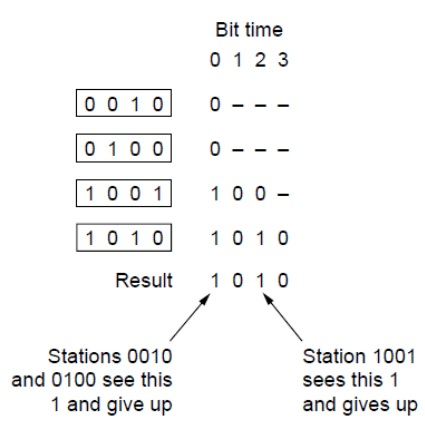
 Data Structure
Data Structure Networking
Networking RDBMS
RDBMS Operating System
Operating System Java
Java MS Excel
MS Excel iOS
iOS HTML
HTML CSS
CSS Android
Android Python
Python C Programming
C Programming C++
C++ C#
C# MongoDB
MongoDB MySQL
MySQL Javascript
Javascript PHP
PHP
- Selected Reading
- UPSC IAS Exams Notes
- Developer's Best Practices
- Questions and Answers
- Effective Resume Writing
- HR Interview Questions
- Computer Glossary
- Who is Who
What is binary countdown protocol in computer networks?
The collision free protocols are of three type and they are as follows −
- Bit map protocol
- Token passing
- Binary countdown
Now let see about binary countdown protocol −
Binary Countdown
The binary countdown is explained below in stepwise manner −
Step 1 − A problem with the bit map protocol and token passing is that overhead is 1 bit per station, so bitmap and token passing will not suit the networks with thousands of stations.
Step 2 − A station wants to use the channel. It has to broadcast its address as a binary bit string starting with a high order bit.
Step 3 − All addresses are assumed to be the same length.
Step 4 − The bits in each address position from different stations are Boolean OR together by the channel when they are sent at same time. WE will call this type of protocol binary countdown.
Step 5 − It implicitly assumes that the transmission delays are negligible so that all stations instantaneously see the asserted bits.
Step 6 − To avoid conflicts an arbitration rule must be applied, whenever a station sees that the high order bit position that is 0 in address has been overwritten with 1 and it gives up.
Step 7 − After winning the bidding a station now transmits a frame after which another bidding cycle starts.
Step 8 − It has the property that higher numbered stations have higher priority than the lower numbered stations, either it may be good or bad depending on context.
The binary countdown protocol, dashes indicate silence.

Here,
The channel efficiency id d/(d+log2N).
The frame format has been chosen so that the sender’s address is the first field in the frame, even these log2N bits are not wasted and the efficiency is 100%.
Binary countdown is an example of simple, elegant, and efficient protocol.

